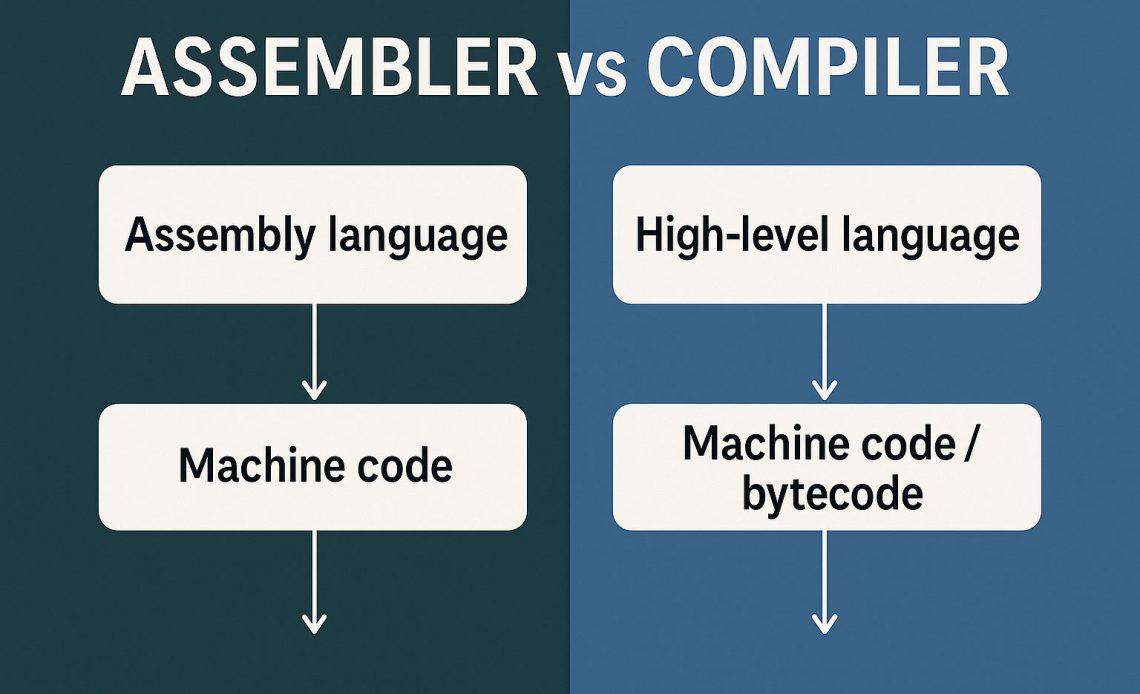
Introduction
Software development spans from high-level languages (like Python or C++) to machine-executable binary. Two crucial tools in this transformation are:
- The Assembler, which translates low-level assembly code into machine code
- The Compiler, which transforms high-level source code into lower-level representations (such as assembly or bytecode)
Though both are translators, they operate at very different abstraction levels.
1. Definitions
What is an Assembler?
An assembler is a program that translates assembly language (which uses human-readable mnemonics) into machine language (binary instructions executable by a CPU).
Example:
MOV AX, BX→1000100110000001
What is a Compiler?
A compiler is a program that translates high-level source code (e.g., C, C++, Java) into:
- Assembly language
- Intermediate code (like LLVM IR or Java bytecode)
- Machine code (in the case of ahead-of-time compilers)
Example:
int x = a + b;→ Assembly or binary code
2. Purpose & Role
| Tool | Role in Software Development |
|---|---|
| Assembler | Converts symbolic CPU instructions to raw binary |
| Compiler | Converts human-friendly code into optimized machine-level code |
Assemblers are used when you write code close to hardware, while compilers manage high-level logic and structure.
3. Abstraction Level
| Feature | Assembler | Compiler |
|---|---|---|
| Language Level | Low-level (Assembly) | High-level (C, Java, etc.) |
| Output | Machine code | Assembly, bytecode, or machine code |
| Abstraction | Very close to hardware | Handles logic, data structures, and memory abstraction |
| Ease of Programming | Difficult | Easier and more productive |
4. Translation Flow
Assembler Flow:
Assembly Code (.asm)
↓
Assembler
↓
Object Code (.o / .obj)Compiler Flow:
High-Level Code (.c / .java / .py)
↓
Compiler
↓
Assembly or Bytecode or Machine CodeSome compilers internally use an assembler to convert their intermediate code into final machine code.
5. Language Examples
| Language Type | Example Languages | Translated By |
|---|---|---|
| High-Level | C, C++, Java, Go | Compilers (GCC, Clang, javac) |
| Low-Level | x86, ARM Assembly | Assemblers (NASM, MASM, GAS) |
6. Code Comparison: C vs Assembly
C Code (compiled by a compiler):
int main() {
int x = 5, y = 10;
int z = x + y;
return z;
}Equivalent x86 Assembly (assembled by an assembler):
section .text
global _start
_start:
mov eax, 5
mov ebx, 10
add eax, ebx
mov ebx, eax
mov eax, 1
int 0x80- Compiler handles types, variables, and logic.
- Assembler requires managing everything manually — including registers and memory.
7. Error Handling
| Category | Assembler | Compiler |
|---|---|---|
| Syntax Errors | Misspelled mnemonics, bad opcodes | Invalid syntax, type errors |
| Semantic Errors | Typically limited | Deep checks: variable scope, types, logic |
| Optimization | Rare (manual) | Built-in: dead code elimination, loop unrolling, etc. |
Compilers are smart translators with built-in analyzers. Assemblers simply translate without interpretation.
8. Output Format
| Output Type | Assembler | Compiler |
|---|---|---|
| Machine Code | ✅ Yes | ✅ Yes (via direct or backend) |
| Object Code | ✅ Yes | ✅ Yes |
| Intermediate Code | ❌ No | ✅ Sometimes (LLVM IR, JVM bytecode) |
| Executable Binary | ❌ No (needs linker) | ✅ Sometimes (e.g., Go, Rust) |
9. Optimizations
| Optimization Feature | Assembler | Compiler |
|---|---|---|
| Loop Unrolling | Manual only | Automatic with optimization flags |
| Dead Code Elimination | No | ✅ Yes |
| Function Inlining | Manual macros | ✅ Often supported |
| Register Allocation | Manual register tracking | ✅ Automatic |
Compilers are much better at generating efficient code unless you are an expert writing handcrafted assembly.
10. Development Workflow Comparison
| Feature | Assembler | Compiler |
|---|---|---|
| Productivity | Low | High |
| Portability | Low (architecture-specific) | High (can recompile to other targets) |
| Debugging Tools | Minimal | Extensive (debug symbols, IDEs) |
| Build System | Simple | Complex (multi-file projects, makefiles, etc.) |
Assemblers are still used in critical performance zones, but most software is written using compilers.
11. When to Use What?
| Scenario | Preferred Tool |
|---|---|
| Writing a device driver | Assembler (or inline) |
| Operating system kernel | Both (C + Assembly) |
| Developing high-performance apps | Compiler |
| Creating firmware for microcontrollers | Often assembler |
| General-purpose software | Compiler |
A modern OS like Linux uses C as the main language, but still relies on assembly for bootloaders, context switching, and interrupt handling.
12. Hybrid Use: Inline Assembly in Compilers
Many compilers support inline assembly, allowing you to mix both:
Example (C with GCC):
int result;
__asm__ ("movl $10, %%eax;"
"movl %%eax, %0;"
: "=r" (result)
:
: "%eax");This allows for manual optimization inside high-level code.
Summary Table
| Feature | Assembler | Compiler |
|---|---|---|
| Input | Assembly language | High-level language (C, Java) |
| Output | Machine code / object file | Assembly / machine code / bytecode |
| Abstraction Level | Low | High |
| Optimization | Manual | Built-in |
| Portability | Low | High |
| Debugging | Minimal | Extensive |
| Use Case | OS development, embedded systems | General-purpose applications |
